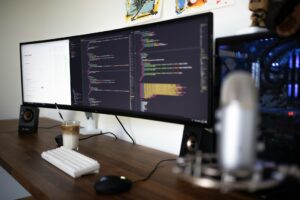Introduction: Finding top talent is essential for any business’s success. Applicant tracking systems (ATS) have transformed hiring by making recruitment smoother and more efficient. With many choices out there, selecting the best recruitment management system can be challenging. This guide will help you discover the best applicant tracking systems, so you can find the perfect fit for your hiring needs.
What is an Applicant Tracking System?
An applicant tracking system is software designed to make hiring easier. It helps employers keep records of job applications, follow up on candidate progress, and have all the data from applicants in one place. This software helps eliminate the manual paperwork that requires more extra effort for every task of recruitment to work at maximum efficiency.
It has many advantages over traditional methods applied since the 1990s. What’s more, it has become an all-in-one tool that takes the hassle out of hiring. Applicant tracking systems automate the screening of candidate profiles, interview scheduling, sorting of cover letters, and resume parsing. They automatically track job seekers and job postings, managing outreach. The best systems also encourage collaborative hiring and support diverse, inclusive practices.
Choosing the Right Applicant Tracking System
With many options available, hiring managers and recruitment teams often wonder how to choose the perfect Applicant Tracking System (ATS). If you’re in this situation, this guide will help you make an informed decision about the best recruitment management system to suit your needs;
Understanding Your Recruitment Needs
Investing in new software such as an ATS takes time and money, so it’s crucial to understand your recruitment needs first. Align your hiring strategies with your business goals to make the right choice.
Start with a workforce analysis to evaluate your team’s performance, skills, and work experience. It will, therefore, show if you are experiencing a shortfall in ability or headcount, which also serves as a review of hiring practices and standard operating procedures.
A detailed analysis brings to light a lack of diversity and inclusivity in your hiring process. It can further highlight, in more granularity, where the hiring process takes time, candidate bottlenecks, and drop-off points in applications.
Moreover, a thorough workforce analysis can forecast future hiring needs. Such data ensures that the recruitment team can have a plan for its future staffing requirements and stay on schedule.
Essential Features of an Effective ATS
Once you understand your recruitment needs, look for key features in an application tracking system that will benefit your organization the most. Every good ATS should include;
User-friendliness: The ATS should be user-friendly and easy to use. Ease of operation is essential, otherwise, highly complex systems will not be put to use.
Automated workflow: Automates interview scheduling, candidate outreach processes, automation in initial screening, assessment administration, role matching, scoring candidates based on different assessment stages, and job posting.
Advanced reporting: Personalized and automated messaging advanced reporting ensures that the tool you use not only allows for the customization of content but also gives a detailed report on all key metrics. The reporting should be in real-time to maintain hiring efforts that are focused and effective. Detailed reporting dashboard highlights underperformance and allows for quick adjustments.
Distribution capability: Your organization needs to know that its recruitment management system can distribute job postings to job boards and social media channels effectively. The distribution capability is a critical consideration.
Industry-Specific Considerations
Hiring needs vary by industry, so your ATS should adapt to specific sector challenges. An effective ATS finds the best talent regardless of industry. For example, pharmaceutical and medical companies need to attract highly educated and skilled individuals. A recruitment management system helps in personalizing and verifying these applications.
Manufacturing companies often hire in large volumes and need a flexible tool for candidate sourcing and onboarding. An application tracking system is essential for attracting, personalizing, and verifying these job applicants while building meaningful relationships.
Financial services require candidates who meet government regulations or hold specific licenses. A good ATS helps sort, score, and validate these candidates.
Your business is unique, so don’t settle for a one-size-fits-all ATS. Choose a provider that offers customization to meet your specific hiring needs.
Evaluating ATS Cost vs. Value
Getting the right candidate is critical mainly when margins are growing thin and the skills gap is growing wide. Replacing an employee involves recruiting, hiring, training, and compensating new hires, which is expensive and it takes considerable time.Therefore, selecting the right candidates becomes crucial.
But it’s not just the more prominent companies that benefit from ATS tools. Small and mid-sized companies, especially those with underdeveloped HR structures and limited HR resources, can also benefit from a robust application tracking system.
These new SaaS solutions, in their pay-per-hire or subscription-based models, make the pricing more attractive for the ATS software. These models reduce implementation costs while providing scalability and reducing time-to-hire metrics. Automation within these systems allows managers to focus on final hiring decisions confidently.
Security and Compliance Factors
Candidates trust that their private information will be handled carefully when they apply in any organization. In order to protect your employee data make sure your application tracking system partner handles data in a secure manner.
To save yourself from the instances of data breaches that could tarnish your reputations, check how the ATS provider manages data storage, encryption, backups, and updates. Ensure they have the proper security certifications and conform to standards such as ISO 27001 and GDPR.
Data access and control measures are equally important. You should be able to manage permissions, view data logs, and handle breaches effectively. Ask the provider how they handle data breaches to understand their level of preparedness and response.
Vendor Support and Training
Human: Any new system is challenging to handle without proper learning, so good vendor support will benefit you during a smooth roll-out. Find out what support and training materials your recruitment management system provider will offer. Instead, look for vendors providing customizable hiring funnels and recruiting steps with learning resources. Good providers offer extensive library resources that will help you learn everything about the platform’s parts.
When issues arise, quick vendor responses are crucial to maintaining operations. Check reviews to understand the vendor’s response times and customer service quality.
Getting Feedback from Stakeholders
If you are not the only user or stakeholder for the ATS, consider feedback from other stakeholders and department heads. Their input may reveal needs that the current system isn’t meeting.
Use this feedback to shortlist ATS platforms for hands-on evaluation. Request demos, conduct pilot tests, and connect with sales teams to understand each option better.
Making the Final Decision
Hands-on trials and demos help you see how an application tracking system works in real scenarios. After comparing top alternatives according to your shortlists, the best option will be the one that can fulfill your needs, budget, and technology.
Take final feedback and make pro-con lists. If required, reach out for senior-level approval. Once the option has been picked, contact the solution provider to start the implementation process.
Top Applicant Tracking Systems for your company
Here is a comparison table of top 10 applicant tracking systems with their unique features and prices;
| Software | Features | Price |
| Rippling | Clocking In and OutLeave ManagementBiometric AttendanceReporting | Starts at $8/user/month |
| Bitrix24 | Attendance TrackingBiometric RecognitionExpense TrackingMobile Access | Starts at $61/month |
| WebWork Time Tracker | Automatic Time CaptureEmployee SchedulingReal-Time ReportingMobile Access | Starts at $4.99/user/month |
| Keka | Biometric RecognitionLeave Policy ManagementOvertime CalculationTime & Expense Tracking | Starts at $20/user/month |
| Tankhwa Patra | Compliance ManagementData Import/ExportPayroll ReportingThird-Party Integrations | Price On Request |
| QuickBooks Time | Employee OnboardingOffline Time TrackingProject SchedulingTagging | Starts at $20/month |
| SecurTime | Biometric RecognitionEmployee DatabaseReal-Time NotificationsOffline Time Tracking | Price On Request |
| Clockify | Facility SchedulingGantt/Timeline ViewMilestone TrackingPercent-Complete Tracking | Starts at $3.99/user/month |
| Gusto | 401(k) TrackingCOBRA AdministrationDirect DepositHIPAA Compliant | Starts at $6/user/month |
Conclusion
Choosing the right applicant tracking system is essential for efficient hiring. By understanding your recruitment needs, evaluating key features, and considering industry-specific challenges, you can find the best recruitment management software for your company. Weigh the cost versus value, ensure strong security and compliance measures, and seek vendor support and training. Involve stakeholders and use hands-on trials to make an informed decision. With the right ATS, you can optimize your hiring process, attract top talents for your business, and meet all your business targets.




